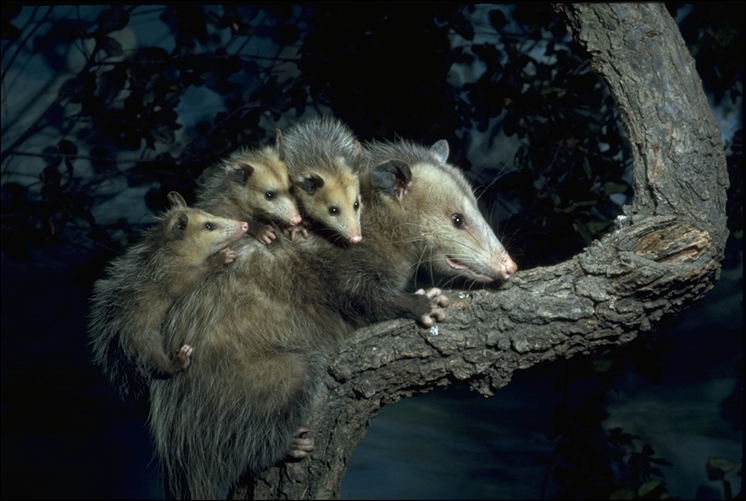
Common opossum, or Southern opossum, or Black-eared opossum, orGamba (Didelphis marsupialis)
Phylum —chordata
Class — mammalia
Order — didelphimorphia
Family — didelphidae
Genus—didelphis
Appearance
Common opossums are robust marsupials. The fur on their body is thick with long guard hairs, leading these animals to appear somewhat disheveled. Their dorsal pelage is often dark, typically blackish or grayish, but in rare instances they may appear whitish. In comparison, their ventral fur is yellow or cream. These animals have primarily whitish fur on their faces and a dark stripe extending to the crown of their heads, with a black ring around both eyes. Their ears are large and all black. Common opossums have sharp claws, long whiskers and a primarily naked prehensile tail that is slightly longer than their body. Common opossums typically have a total body length of 371 mm (ranging from 265 to 430 mm), including a tail length of 395 mm.
Habitat
Common opossums are found throughout much of Central and South America. These animals are found native to the following countries: Argentina, Belize, Bolivia, Brazil, Columbia, Costa Rica, Ecuador, El Salvador, French Guiana, Guatemala, Guyana, Honduras, Mexico, Nicaragua, Panama, Paraguay, Peru, Suriname, Trinidad, Tobago and Venezuela.
Behavior
Their activity is mainly nocturnal and terrestrial, with some arboreal exploration and nesting. Outside of mating, they are usually solitary. They are considered pests due to their somewhat raccoon-like behavior. Raiding trash cans, nesting in locations that are not suitable, and causing mayhem if encountered within a human living space, they are often trapped and killed.
Diet
Common opossums have a broad ability to adapt to environmental changes, and their teeth allow them to eat many different types of food, which is obtained mostly on the ground. They can eat small insects, small animals, fruits, vegetables, and also carrion. Their ability to digest almost anything edible gives them a broader range than a human.
Reproduction
Common opossums show a polygynous mating system, in which males compete for reproductive females. These animals are almost exclusively solitary, but come together seasonally for breeding. When resources are limited or unavailable these animals may choose not to mate.
Breeding seasons and the number of annual litters varies based on latitude. Breeding seasons can vary from one long season from January to September or several shorter seasons annually. These seasons may be correlated with seasonal precipitation. Female Common opossums begin breeding when they are 6 to 7 months old. Gestation typically lasts 13 to 15 days, after which 2 to 20 altricial young are born, interestingly; animals living closer to the equator tend to have smaller litters. At birth, their young are tiny; they are usually about 1 cm long and weigh about 0.13 grams. Although they are extremely under-developed, newborn Common opossums have well-developed claws on their front legs that help them climb to their mother’s pouch. Once inside the pouch, their young remain attached to the mammae for about 50 days. Common opossums offer very little parental care. Males have no involvement in raising their offspring and females invest a minimal effort.
Young are weaned and independent when they are 90 to 125 days old, often when fruit is plentiful.
The Common opossum lives for around 2.5 years.
In captivity
Opossums are easily tamed for a captivity and become completely whimsical. They like to sit on their keepers‘ hands and heads. It is an instinct kept from childhood, when they traveled on their mother's back.
In the process of education, opossums should not be punished. Any severe punishment can lead to aggression. Also, aggression can be shown when the opossum is constantly kept in the cage. The opossum must have daily contact with a human if you want it to be tamed.
Opossums are excellent climbers and they do not have any difficulty in climbing up a tree, or on a wardrobe. Therefore, the apartment will need to organize special devices so that the animal can climb them.
It is no more difficult to train opossums to go to a toilet than to train a cat or a ferret. Put the tray next to their sleeping place, as well as in those rooms where you walk the animal.
Opossums do not require frequent bathing. A healthy opossum has no smell. Opossums are quite clean animals and take care of their skins.
The animal should be placed away from heating means (battery, microwave), be protected from drafts, as well as from direct sunlight.
The lifespan of opossums depends directly on their nutrition. Opossums will not live long if you feed them only factory-produced feed. The opossum's diet should consist of natural fresh or frozen foods, but in no case of ready-made feed. Also, the opossum cannot be fed beef and pork. In captivity, the animal is given chicken meat, boiled eggs, cottage cheese, fruit (mainly apples). Fruit can be given 2-3 times a week. Also, the menu of the animal should consist fish, mealworms, grasshoppers, cheese, yogurt and other dairy products, vegetable oil, nuts. Sometimes opossums are allergic to nuts. But this is rare.
The cage should be cleaned as often as possible (at least once a week). Opossums need constant access to water.
The opossum is a nocturnal animal, and they sleep during the day. However, domestic opossums often adapt to the rhythm of their owner's life.Also, opossums have a low body temperature - and because of this, they do not have fleas.
 Russian
Russian
 English
English
























